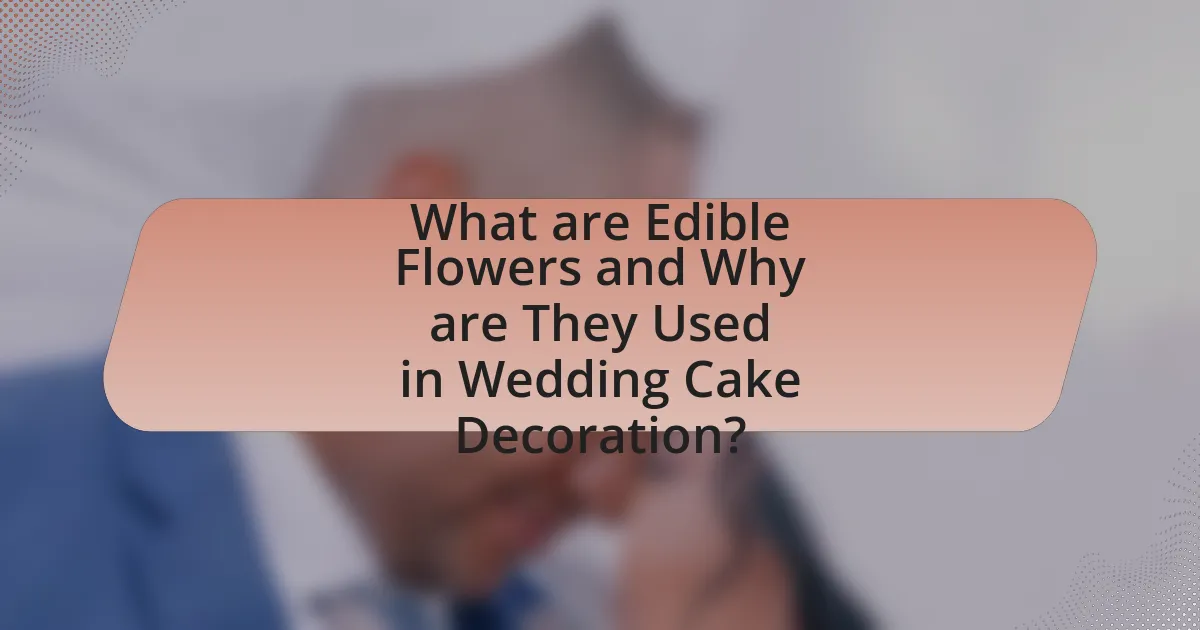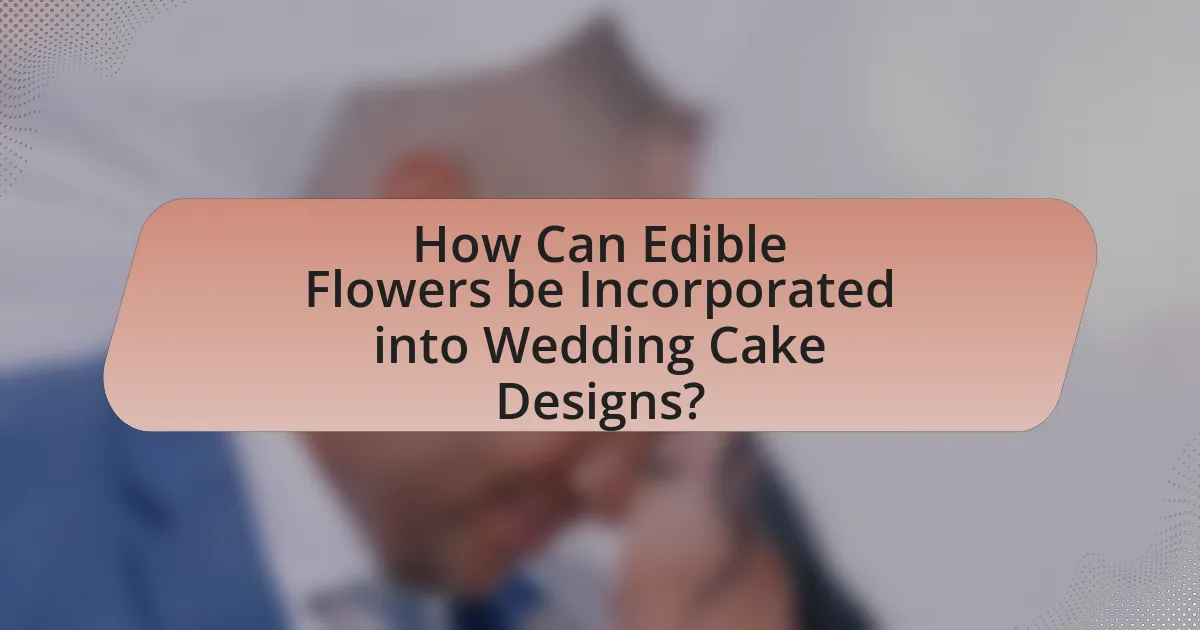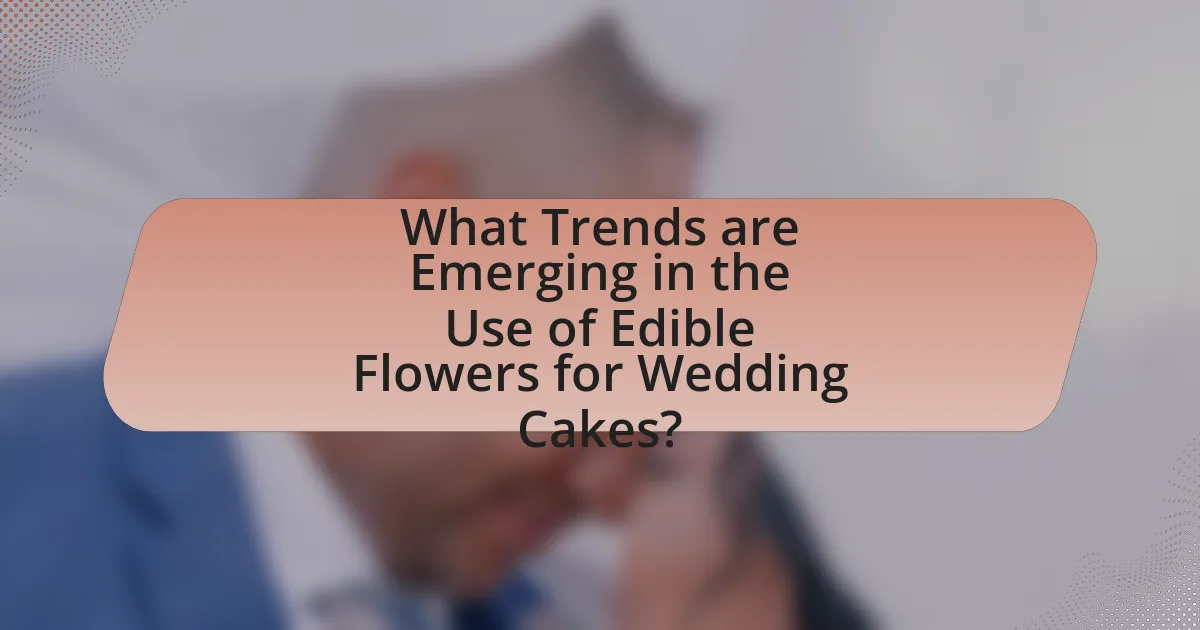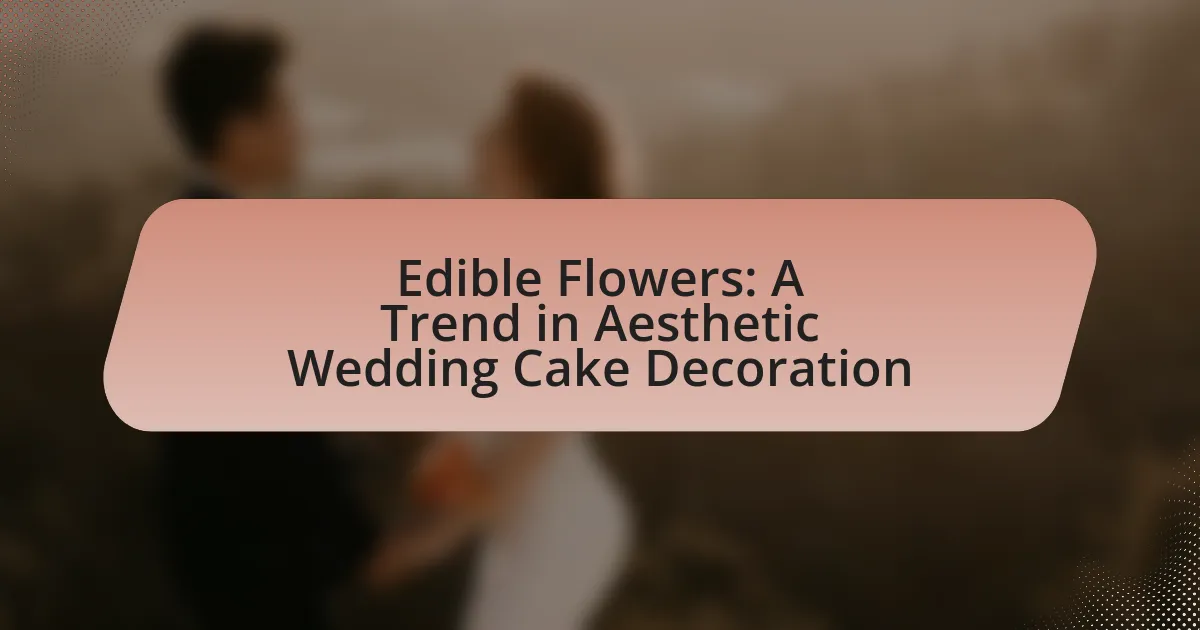Edible flowers are blossoms safe for human consumption, increasingly used in wedding cake decoration to enhance both aesthetic appeal and flavor. Popular varieties include roses, pansies, and violets, which contribute vibrant colors and unique tastes, aligning with modern wedding themes that favor natural and organic elements. The article explores how edible flowers enhance the visual appeal of cakes, complement various designs, and provide health benefits, while also addressing considerations for safety, sourcing, and seasonal availability. Additionally, it highlights emerging trends in personalization and the influence of social media on the popularity of edible flowers in contemporary wedding celebrations.

What are Edible Flowers and Why are They Used in Wedding Cake Decoration?
Edible flowers are blossoms that are safe for human consumption and are often used in culinary applications, including wedding cake decoration. These flowers, such as pansies, violets, and nasturtiums, add visual appeal, vibrant colors, and unique flavors to cakes, enhancing their aesthetic and taste. The use of edible flowers in wedding cakes has gained popularity due to their ability to create a natural, elegant look that aligns with modern wedding themes. Additionally, many edible flowers are rich in nutrients and can provide health benefits, making them a desirable choice for couples looking to incorporate fresh, organic elements into their celebration.
How do Edible Flowers Enhance the Aesthetic of Wedding Cakes?
Edible flowers enhance the aesthetic of wedding cakes by adding vibrant colors, unique textures, and natural beauty. These flowers serve as eye-catching decorations that can complement the cake’s design and theme, creating a visually appealing centerpiece for the wedding. For instance, varieties like roses, pansies, and violets not only provide a pop of color but also evoke a sense of elegance and romance, which are essential elements in wedding aesthetics. Additionally, the use of edible flowers aligns with the trend of incorporating natural elements into wedding decor, making cakes look more organic and artisanal. This trend is supported by the growing popularity of farm-to-table concepts in catering, where fresh, locally sourced ingredients are favored, further validating the aesthetic appeal of using edible flowers in wedding cakes.
What Visual Appeal do Edible Flowers Bring to Wedding Cakes?
Edible flowers enhance the visual appeal of wedding cakes by adding vibrant colors, unique textures, and natural elegance. These flowers serve as eye-catching focal points, creating a stunning contrast against the cake’s frosting and design. For instance, varieties like roses, pansies, and violets not only provide aesthetic beauty but also contribute to a romantic and whimsical atmosphere, aligning with wedding themes. The use of edible flowers is supported by trends in wedding decor, where couples increasingly seek personalized and visually striking elements, making cakes adorned with these flowers a popular choice for enhancing overall wedding aesthetics.
How do Edible Flowers Complement Different Cake Designs?
Edible flowers enhance different cake designs by adding visual appeal, texture, and flavor. They serve as natural decorations that can complement various themes, from rustic to elegant, by providing vibrant colors and intricate shapes that align with the overall aesthetic. For instance, roses can evoke romance in wedding cakes, while wildflowers can contribute to a bohemian style. Additionally, edible flowers like lavender and hibiscus can introduce unique flavors that elevate the cake’s taste profile, making them not only decorative but also functional. This dual role of enhancing both appearance and flavor solidifies their popularity in cake decoration, particularly in the context of aesthetic wedding cakes.
What Types of Edible Flowers are Popular for Wedding Cakes?
Popular types of edible flowers for wedding cakes include roses, peonies, and violets. Roses are favored for their classic beauty and variety of colors, while peonies add a lush, romantic touch due to their large blooms. Violets are appreciated for their delicate appearance and vibrant hues. These flowers not only enhance the visual appeal of wedding cakes but are also safe for consumption, making them a popular choice among couples looking to incorporate natural elements into their cake designs.
Which Edible Flowers are Safe for Consumption?
Edible flowers that are safe for consumption include nasturtiums, pansies, violets, marigolds, and calendula. These flowers are commonly used in culinary applications due to their non-toxic nature and appealing flavors. For instance, nasturtiums have a peppery taste, while pansies and violets offer a mild sweetness. The safety of these flowers is supported by their historical use in various cuisines around the world, where they have been incorporated into salads, desserts, and garnishes.
How do Different Edible Flowers Vary in Flavor and Appearance?
Different edible flowers vary significantly in flavor and appearance, with each type offering unique characteristics. For instance, nasturtiums have a peppery taste and vibrant orange or yellow petals, while pansies are mild in flavor and come in a range of colors, including purple, yellow, and blue. Additionally, violets possess a sweet, floral flavor and typically feature purple or white petals. Marigolds, on the other hand, have a citrusy taste and bright yellow or orange blooms. These variations in flavor and appearance make edible flowers versatile for enhancing the aesthetic and taste of wedding cakes.
What Considerations Should be Made When Using Edible Flowers on Wedding Cakes?
When using edible flowers on wedding cakes, it is essential to ensure that the flowers are safe for consumption and free from pesticides. Edible flowers such as pansies, nasturtiums, and violets are commonly used, but not all flowers are edible; for example, some varieties of lilies and daffodils are toxic. Additionally, the flavor profile of the flowers should complement the cake’s taste, as some flowers can be bitter or overpowering. It is also important to consider the visual appeal and color scheme of the wedding cake, as the flowers should enhance the overall aesthetic. Finally, proper handling and storage of the flowers are crucial to maintain freshness and prevent contamination.
How do Seasonal Availability and Sourcing Affect Flower Choices?
Seasonal availability and sourcing significantly influence flower choices for wedding cake decoration. Flowers that bloom during specific seasons are more readily available and often fresher, leading to better quality and aesthetic appeal. For instance, peonies are typically available in late spring to early summer, making them a popular choice for weddings during that time. Additionally, sourcing flowers locally can enhance sustainability and reduce transportation costs, further impacting the selection process. Research indicates that using seasonal flowers can lower costs by up to 30% compared to out-of-season varieties, making them a practical choice for couples planning their weddings.
What Safety Precautions Should be Taken When Using Edible Flowers?
When using edible flowers, it is essential to ensure they are safe for consumption by sourcing them from reputable suppliers who confirm they are pesticide-free and specifically grown for culinary use. Additionally, individuals should verify that the flowers are indeed edible, as some flowers can be toxic; for example, certain varieties of lilies and daffodils are harmful if ingested. It is also crucial to wash the flowers thoroughly to remove any contaminants before use. According to the American Society for Horticultural Science, proper identification and sourcing of edible flowers significantly reduce the risk of adverse reactions.

How Can Edible Flowers be Incorporated into Wedding Cake Designs?
Edible flowers can be incorporated into wedding cake designs by using them as decorative elements, flavor enhancers, or both. Bakers often place fresh edible flowers like roses, violets, or lavender on the cake’s surface or between layers to create visually appealing arrangements. Additionally, edible flowers can be infused into cake batter or frosting to impart unique flavors, enhancing the overall taste experience. The use of edible flowers in wedding cakes aligns with the growing trend of natural and organic ingredients, appealing to couples seeking a rustic or elegant aesthetic. This trend is supported by the increasing popularity of floral-themed weddings, where flowers serve not only as decoration but also as a key component of the culinary experience.
What Techniques are Used to Arrange Edible Flowers on Cakes?
Techniques used to arrange edible flowers on cakes include strategic placement, color coordination, and layering. Strategic placement involves positioning flowers at focal points, such as the top or sides, to enhance visual appeal. Color coordination ensures that the flowers complement the cake’s color scheme, creating a harmonious look. Layering techniques involve placing flowers at different heights and depths to add dimension and texture, making the arrangement more dynamic. These methods are widely recognized in cake decoration, as they contribute to the overall aesthetic and elegance of wedding cakes.
How do Different Arrangements Impact the Overall Look of the Cake?
Different arrangements of edible flowers significantly enhance the overall look of a cake by adding visual interest, depth, and elegance. For instance, a symmetrical arrangement creates a formal and balanced appearance, while an asymmetrical layout can evoke a more modern and artistic feel. Research indicates that the placement and variety of flowers can influence perceptions of freshness and luxury, with studies showing that cakes adorned with vibrant, well-placed flowers are often perceived as more appealing and desirable. This aesthetic impact is crucial in wedding cakes, where presentation plays a vital role in the overall experience.
What Tools and Materials are Needed for Flower Arrangement on Cakes?
To create flower arrangements on cakes, essential tools and materials include floral tape, wire, scissors, and edible flowers. Floral tape secures the flowers in place, while wire provides support for delicate blooms. Scissors are necessary for trimming stems to the desired length, ensuring a clean cut for better placement. Edible flowers, such as pansies, roses, and violets, are chosen for their aesthetic appeal and safety for consumption. These materials collectively enable effective and visually pleasing arrangements on cakes, aligning with the trend of using edible flowers in wedding cake decoration.
What Are Some Creative Ideas for Using Edible Flowers in Wedding Cakes?
Edible flowers can be creatively used in wedding cakes by incorporating them as decorative elements, flavor enhancers, and natural colorants. For decoration, flowers like roses, peonies, and violets can be arranged on the cake’s tiers or used to create floral garlands, adding elegance and visual appeal. As flavor enhancers, flowers such as lavender and hibiscus can be infused into cake batters or frostings, providing unique tastes that complement traditional flavors. Additionally, edible flowers can serve as natural colorants; for instance, marigold petals can impart a vibrant yellow hue to buttercream. These uses not only enhance the cake’s aesthetic but also align with the growing trend of incorporating natural ingredients into wedding desserts.
How Can Edible Flowers be Used in Layered Cake Designs?
Edible flowers can be used in layered cake designs by incorporating them as decorative elements between layers, on top of the cake, or as accents around the base. This practice enhances the visual appeal and adds unique flavors, as many edible flowers, such as pansies and nasturtiums, are not only safe to eat but also contribute to the overall taste profile of the cake. The use of edible flowers in cake decoration has gained popularity due to their vibrant colors and natural beauty, making them a favored choice for aesthetic wedding cake designs.
What Unique Themes Can be Enhanced with Edible Flowers?
Edible flowers can enhance unique themes such as rustic, garden, bohemian, and romantic aesthetics in wedding cake decoration. For instance, a rustic theme benefits from the natural look of wildflowers, while a garden theme can be accentuated with vibrant blooms like pansies and nasturtiums. Bohemian styles often incorporate a mix of colors and textures, which edible flowers can provide, creating a free-spirited vibe. Romantic themes are complemented by delicate flowers like roses and violets, adding elegance and charm. These enhancements not only elevate the visual appeal but also align with the growing trend of incorporating natural elements into wedding celebrations.

What Trends are Emerging in the Use of Edible Flowers for Wedding Cakes?
Emerging trends in the use of edible flowers for wedding cakes include a growing preference for organic and locally sourced blooms, as couples increasingly seek sustainable options. Additionally, there is a rise in the use of vibrant, unconventional flower varieties, such as hibiscus and borage, which enhance visual appeal and flavor. The trend also reflects a shift towards minimalist designs, where edible flowers serve as focal points rather than mere accents, creating a more natural and elegant aesthetic. This trend is supported by the increasing popularity of floral-themed weddings and the desire for unique, personalized cake designs that reflect individual tastes and styles.
How are Couples Personalizing Their Wedding Cakes with Edible Flowers?
Couples are personalizing their wedding cakes with edible flowers by selecting specific blooms that reflect their individual tastes and wedding themes. This trend allows couples to incorporate seasonal flowers, such as peonies or roses, which not only enhance the visual appeal of the cake but also add unique flavors and textures. According to a survey by The Knot, 30% of couples now opt for floral decorations on their cakes, showcasing the growing popularity of this customization. Edible flowers also provide a sustainable option, as they can be sourced locally and align with eco-friendly wedding practices.
What Role do Social Media and Influencers Play in Popularizing Edible Flowers?
Social media and influencers play a crucial role in popularizing edible flowers by showcasing their aesthetic appeal and culinary versatility. Platforms like Instagram and TikTok allow influencers to share visually striking images and videos of dishes adorned with edible flowers, which attracts attention and encourages followers to incorporate them into their own cooking and baking. For instance, the hashtag #edibleflowers has garnered millions of posts, demonstrating widespread interest and engagement. This visibility not only educates consumers about the use of edible flowers but also drives demand, as influencers often collaborate with brands to promote specific products, further embedding edible flowers into contemporary culinary trends.
How are Edible Flowers Being Used in Non-Traditional Wedding Cake Designs?
Edible flowers are increasingly being incorporated into non-traditional wedding cake designs as a means to enhance visual appeal and add unique flavors. Bakers and cake designers utilize a variety of edible flowers, such as pansies, roses, and lavender, to create vibrant, colorful decorations that align with modern aesthetic trends. This practice not only elevates the cake’s presentation but also allows couples to personalize their wedding cakes with flowers that may hold special significance or complement their wedding theme. The use of edible flowers in cake decoration has been supported by culinary experts who emphasize their ability to provide both beauty and taste, making them a popular choice in contemporary wedding celebrations.
What Tips Should Couples Consider When Choosing Edible Flowers for Their Wedding Cake?
Couples should consider the safety, flavor, and aesthetic appeal of edible flowers when choosing them for their wedding cake. Safety is paramount; only select flowers that are confirmed to be edible and free from pesticides, such as pansies, nasturtiums, and violets. Flavor is also important; some flowers can be bitter or overpowering, so couples should taste-test them to ensure they complement the cake’s flavor profile. Aesthetic appeal should align with the wedding theme; vibrant colors and unique shapes can enhance the cake’s visual presentation. Research indicates that edible flowers not only add beauty but can also elevate the overall dining experience, making them a popular choice in modern wedding cake design.
How Can Couples Ensure the Freshness and Quality of Edible Flowers?
Couples can ensure the freshness and quality of edible flowers by sourcing them from reputable suppliers who specialize in organic and pesticide-free varieties. Fresh edible flowers should be harvested in the morning when temperatures are cooler, as this preserves their moisture and flavor. Additionally, couples should inspect the flowers for any signs of wilting or discoloration before use, as these indicators suggest reduced freshness. Proper storage is also crucial; keeping edible flowers in a cool, dry place or refrigerating them in a breathable container can extend their shelf life. Research indicates that flowers stored at optimal temperatures maintain their quality longer, making these practices essential for ensuring the best possible experience in wedding cake decoration.
What Common Mistakes Should be Avoided When Using Edible Flowers on Cakes?
Common mistakes to avoid when using edible flowers on cakes include using non-edible varieties, neglecting to wash the flowers, and failing to consider flavor compatibility. Non-edible flowers can be toxic and harmful if consumed, so it is crucial to ensure that only safe, edible varieties are used. Additionally, not washing the flowers can lead to pesticide residues or dirt being transferred to the cake, compromising food safety. Lastly, pairing flowers with flavors that clash can detract from the overall taste experience; for example, using a strongly flavored flower like lavender with a delicate vanilla cake may overwhelm the palate.
